How’s your tomato year? Mine is 50/50.
In part of my garden, I have grown varieties that don’t claim any disease resistance; they are open-pollinated varieties that are different shapes and colors. They are delicious, and the plants produced well for a while but are now burned up.
In another part of my garden, I have grown hybrid varieties that claim broad disease resistance — to fusarium wilt and late blight and many others, but most importantly to nematodes. I have root-knot nematodes in this part of my garden.
So I had low expectations for these plants. Last year’s tomatoes in this area did not do great. Yet each of these five hybrid varieties has won me over, earning the right to be planted in following years, and I wouldn’t hesitate recommending that you try them in your garden, especially if yours have struggled with root-knot nematodes or other diseases. Let me briefly introduce them to you.
Mountain Fresh Plus
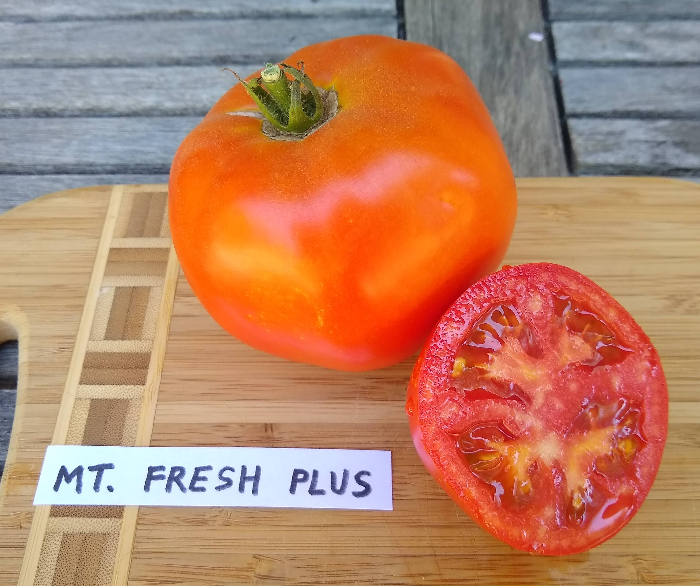
Mountain Fresh Plus is the Platonic idea of a tomato. It’s not perfect, but it is perfectly typical. It is medium to large, red, and round. It looks like a tomato that you would see in a painting.
BHN-1021
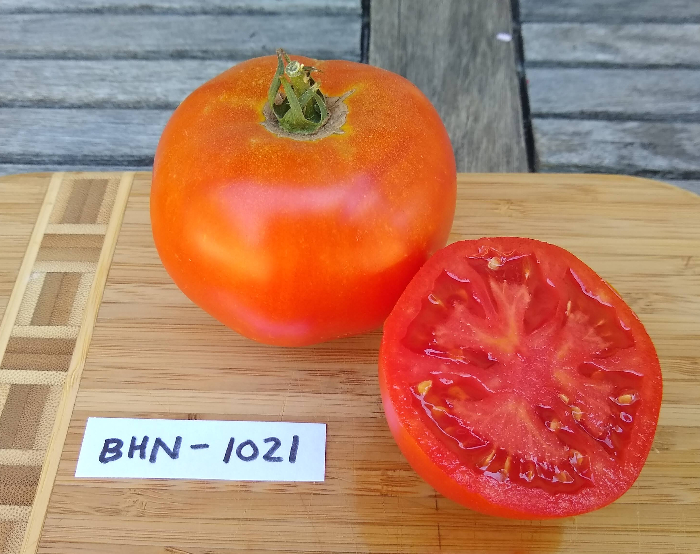
BHN-1021 is almost the same as Mountain Fresh Plus in every way, just look at the photos above. Both have good, expected tomato flavor.
Here are the plants:
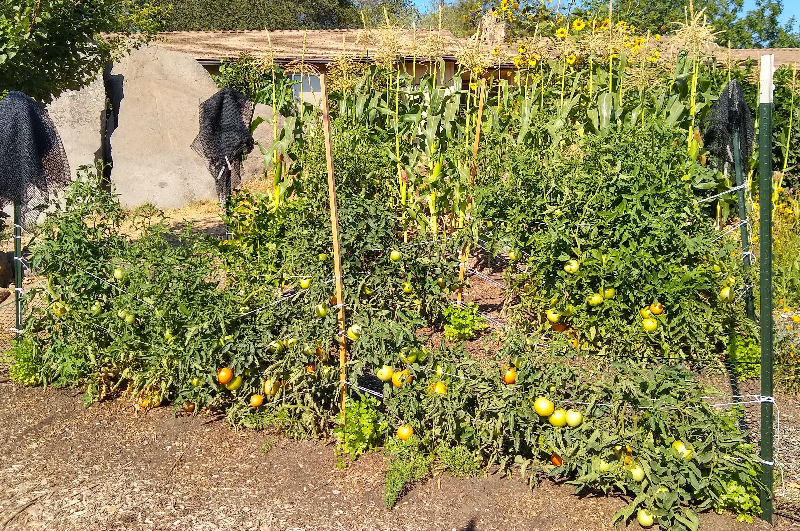
The above photo was taken on July 13 when my tomato plants were coming into full production this summer. The Mountain Fresh Plus and BHN-1021 plants are in the front row on the right side, where you can notice that they are productive and smaller than the other plants. Both Mountain Fresh Plus and BHN-1021 plants are efficient fruiters, as they make lots of tomatoes on compact plants.
Big Beef
Big Beef, on the other hand, is both a larger plant and a slightly larger fruit.
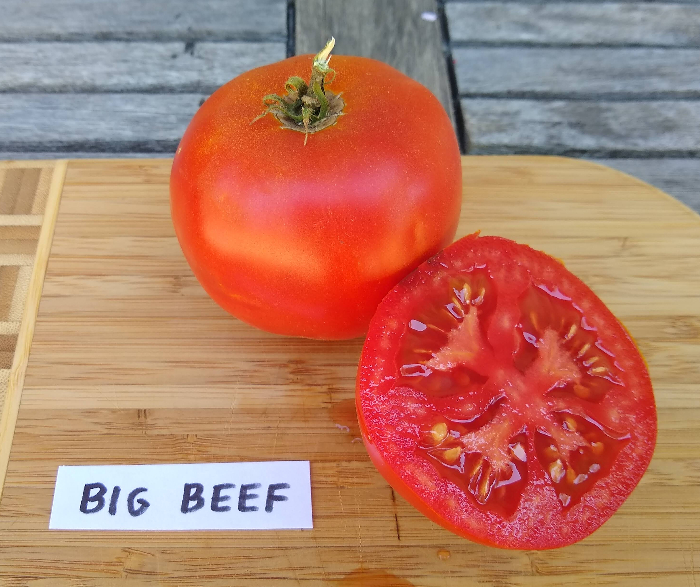
The flavor of the fruit is excellent and slightly milder and fruitier than Mountain Fresh Plus and BHN-1021.
Big Beef fruit has also had slightly less skin cracking, and I think this is partly due to the vigorous plant that shades its fruit well. Here are my Big Beef plants:

Damsel
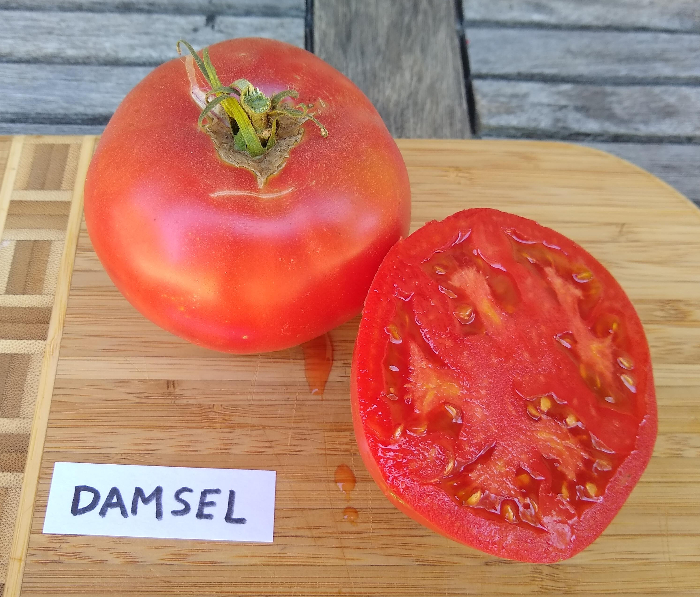
Do you see the pinkish color? Damsel is a beautiful tomato. Over the past few weeks, when we’ve had extra tomatoes to give to friends I’ve wanted to give them Damsels because of how attractive they are, and they also seem to have a slightly richer flavor — although I sometimes wonder if the unusual hue of the fruit is influencing my sensation of its taste.
The size of the Damsel plants are in between the big Big Beef plants and the compact Mountain Fresh Plus and BHN-1021 plants.
One downside to Damsel is that the fruit sometimes gets concentric cracks around the stem or green shoulders if they are not shaded well under leaves or shade cloth.
Lemon Boy
Finally, we have Lemon Boy. I hadn’t planned on growing Lemon Boy this year, but neighbors kindly gave me a plant, and when I looked the variety up and found that it claimed root-knot nematode resistance, I put it in the infested area of my garden — and it has thrived.

The Lemon Boy fruit’s flesh is meaty and its flavor has less acid and a bit more of a tropical taste. I have loved adding a bit of diced Lemon Boy into my salsas this summer. The Lemon Boy plant is large and fruitful, yet not quite as productive as the above red varieties mentioned in this post.
The above five varieties are all excellent, workhorse tomatoes that seem to fulfill their claims to disease resistance. I can attest that they definitely thrive despite the root-knot nematodes in the soil of my garden, and I’ve seen no other diseases affecting the plants.
I bought my seeds for the above varieties from Johnny’s and Territorial: Mountain Fresh Plus, BHN-1021, Big Beef, Damsel. Lemon Boy seeds are widely available, and plants are often found at nurseries.
All of my Yard Posts are listed HERE
My Yard Posts have no ads because of your support. Thanks. Here’s how you can support.

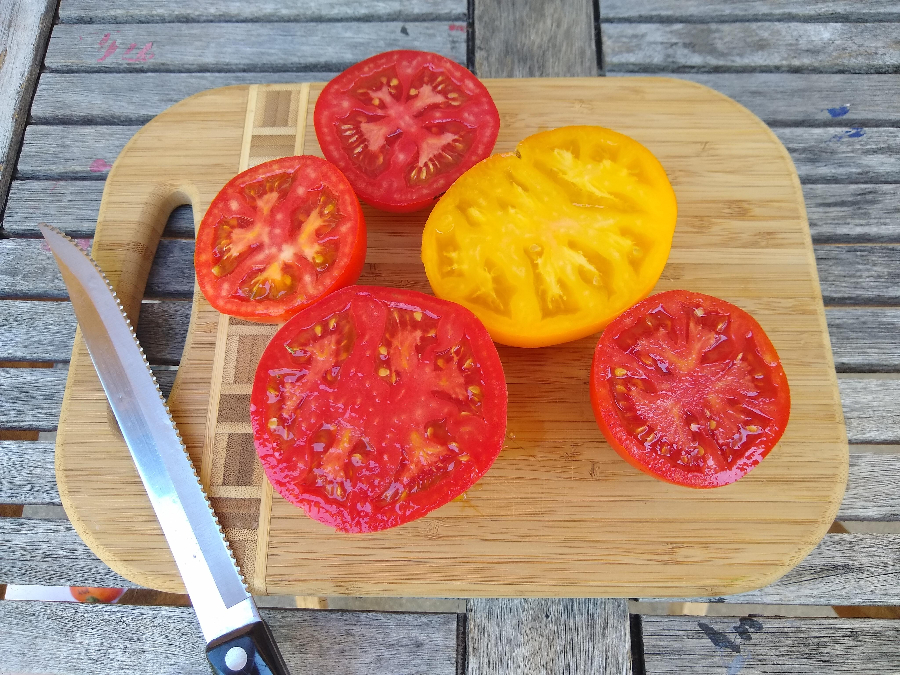


Thanks for this post, Greg! I’m taking note of these varieties. As I’ve commented on another of your posts, I also have RKN in a bed and decided to solely grow RKN resistant tomatoes and marigolds in it this year. I planted Celebrity and Better Boys and, unfortunately, neither did well. I went ahead and pulled the plants and was surprised to not find one root gall in the bunch! There’s clearly something else going on in that bed. Even the marigolds were underwhelming. I’ll be soil testing to see if I can determine what’s up, but I can attest that Celebrity and Better Boy do also seem to live up to the RKN resistance claim.
I’ve been growing better boy every year for many many years and it is my favorite tasting tomato. I planted trees that shaded my favorite area for growing tomatoes therefore I moved them to a sunny location. I loaded the soil with organics and then all my tomatoes had end rot. Doing research I found it was caused by lack of calcium. I loaded the soil with bone meal and gypsum and now it’s rare to find any end rot. I also add steer manure each year.
Hi Adrien and Richard,
I’ll add Celebrity and Better Boy to my list for next year. I have had good results in the past with Celebrity in areas not infested with RKN so I’ll see how it does under RKN pressure. Thanks for the reports.
No matter how much calcium is in the soil, it seems like my very first maters always get the blossom end rot. But after that, no sweat. Watch out for salt content in steer manure. Gypsum is good. Gypsum helps leach out sodium by replacing it with calcium.
My tomatoes have been getting curly top and something that makes leaves and stems yellow. Cutting off the yellow part above the green seems to extend harvest. The curly thing is a total failure to thrive. I had one plant survive the curl and saved the seeds.
A friend of mine thinks that you could have lots of calcium in the soil but something keeps the plant from taking it up, that might be something you want to research. I add steer manure to the soil and other nutrients as well before we have the rain in San Diego. I also add soil amendments made by Kellogg’s, growmulch. I took someone’s advice and asked the plants grew taller I stripped the leaves and stems off the lower part of the plant. It’s supposed to help prevent fungus.
yeah it is unlikely in So Cal to be calcium deficient, the tap water is generally pretty hard. The times i have had problem with end rot was when i added too much nitrogen in the early part of the cycle. ammonium nitrates can block the uptake of calcium.
Do you ever write about growing Marijuana in CA? Does anyone have experience growing outside – near the coast. My first try did not turn out so well.
Thanks Mark
I follow your posts and appreciate them, but this is the first time I’ve made a comment. This particular post is so helpful! I like the photos, the exact names of the plants and your comments. I keep a gardening book so I know what I planted and how it did, along with photos. That’s probably why I like this post so much! 😉 Thank you for so freely spreading your knowledge.
Greg, we have a small community garden of raised beds. At least five beds have tomatoes planted in them, all from different gardeners and different sources, and ALL have developed Early Blight. Is there a chance that this is airborne? Or is it the way that they are watered (water on the leaves). Lastly, what is there to do about it? Should we leave them in the ground? Some are producing, but some of the tomatoes have an iridescent sheen on the skin. Please advise. Thanks!
What worked best this summer in a garden with a fair amount of RKN:
– Chocolate Sprinkle cherry tomatoes didn’t have too many galls and the plants stayed healthy through July. Fairly rich tomato flavor, though not up at the level of Cherokee Purple or others.
– Big Beef: plants stayed healthy through July, flavor was OK.
– Roman Warrior paste tomatoes: productive, flavor OK.
– First prize was productive, but bland.
I’ve been trying to deal with RKN when growing tomatoes for four years now. We don’t have a lot of space for gardening, so it is hard to rotate crops to the extent of avoiding filling a section with plants that don’t host nematodes for several years running. Most food plants seem to be at least somewhat susceptible. I was going to try my hand at grafting heirlooms onto highly resistant root stock this past winter, but the seedlings matured at such different rates it didn’t work out. Next year I think I’ll try again, or grow the tomatoes in partially buried 5 gal bags of potting mix.
Arugula helps knock down the levels of RKN when used as a cover crop: they invade the roots but are unable to reproduce.
Hi Mike,
Thanks for this contribution. I had also thought of grafting some heirlooms onto RKN-resistant rootstock this year but didn’t get around to it. Hopefully I can next year.
I realize this is an older post, but on the off chance you’re still checking comments, I wonder if you’ve tried grafting tomatoes? I tried a small experiment last year with grafted/ungrafted san marzano and damsel planted side by side. In both cases the grafted plants made more tomatoes, larger tomatoes, with no end rot. The ungrafted plants had some end rot, were slightly earlier to ripen, and became weak and unproductive in August. The grafted plants were still growing and making fruit when I ripped them out in November. They probably would have kept going all winter, but I have learned from past experience never to overwinter tomatoes or peppers due to thrips/TSWV. Another big plus is being able to grow any variety you want, even with RKN. Tomato grafting is quite a bit of extra work though, and not nearly as fun as fruit tree grafting. My experiment was intended to prove it isn’t worth the hassle, but ended up proving the opposite. So this spring I’m once again grafting my tomatoes to Estamino rootstock despite the hassle.
Hi Abe,
Thanks so much for sharing this. I have thought about grafting tomatoes for years but never actually done it because of the cost and hassle, but maybe my time has come!
Where did you buy your Estamino rootstock?
I got Estamino from Johnny seeds. I also tried RST-04-105-T from NE seed in the past, but it was less successful for me at my location near the coast.
My favorite (tastiest) RKN-resistant tomatoes are Purple Boy F1 and Chocolate Sprinkles F1. I tried Damsel F1 last year and it didn’t produce much, but I’m trying it again this year. Bush Early Girl F1 was very productive, especially for a determinate, and it produced nonstop until frost.
A couple plants that are not rated as RKN resistant, but that did well surrounded by other plants that had RKN damage, were Polaris and Benevento F1. These are my two favorite tomatoes.
I planted a Kodiak mustard cover crop in the winter to suppress nematodes, and so far the tomato plants in those beds are vigorous and healthy. It was a lot of work to chop up and incorporate the mustard!!!
I’m in central CA.
Tanya,
I’m very grateful for this contribution. Thanks for taking the time.
I’m going to try some of your varieties, and I’d like to plant the mustard in one of my beds this winter and see if tomatoes do better in it versus another.
This summer, my best performers are Mountain Fresh Plus and BHN-1021, with good growth and fruit yields.